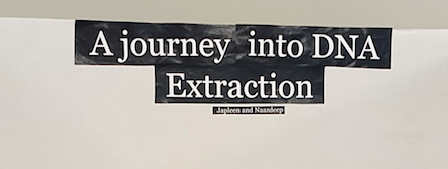A journey into DNA extraction
Grade 6
Presentation
No video provided
Hypothesis
We think that strawberries are more likely to produce more DNA than fruits like kiwi’s and bananas. Since strawberries are octoploid which means they have eight sets of chromosomes, they have much more DNA in each cell. Kiwi’s are hexaploid meaning the fruit has six sets of each chromosomes. Bananas are triploid which means they have three sets of chromosomes rather than two.
Research
The fruit which yields the most DNA is strawberry, second is kiwi, and the least compared to both these fruits is banana. The reason being why strawberries yield the most DNA compared to the other fruits is because they have large genomes and are octoploid which means they have 8 sets of each chromosome.
Cells are small units in our bodies, a cell contains many parts inside it.
The nucleus is located in the center of the cell and acts as a control center as it holds all the genetic information.
Chromosomes are thread-like structures located in the nucleus of the cell. These are made of proteins and a single molecule of DNA.
DNA is located in the chromosome of the cell and determines how we look, develop and function.DNA carries the genetic information of every living thing.
A project was conducted at the California Science and Engineering Fair in the year 2018 by Makena Bailey and Kyra Phaychanpheng’s project. It is the process of extracting DNA from fruits using different Cell Lysis Buffers”. Its main objective was to learn how to extract DNA from strawberries,bananas, and raspberries and to determine which fruit yields more DNA and which the solution helps the fruits precipitate more DNA. Their hypothesis was that strawberries will have more DNA than raspberries and bananas which was accurate.
To extract the DNA, they used a special technique “CLB” Cell Lysis Buffer which breaks down the cell membrane. After 27 tests, they found out that raspberries had the most DNA with an average of 0.21g and bananas had the least with the average being 0.089 g.
Fruit mashing : When we mashed the fruit, it broke the cell wall.
Extraction liquid: The salt separated the cells from each other and is also used to clump all the DNA in the final step. The dish soap ruptured the cell membranes and help to release the DNA.
Sieve the mixture: It helps to collect all the fruit water and get rid of fruit remains.
Adding cold Isopropyl alcohol: Adding the cold isopropyl alcohol slowed down the enzymes which breaks the DNA, This is the reason why we have to use a certain amount of time.
Variables
Manipulated Variable: Fruits
Constant Variable: Amount of extraction liquid, Isopropyl alcohol, temperature, pressure, Amount of fruit puree, time of extraction
Responding Variable: Yield of DNA
Procedure
- Add 2 tablespoons and 3 teaspoons of water into a bowl.
- Add 1 tablespoon of liquid dish soap, ½ teaspoon of salt and mix well, to make the extraction liquid
- Put 3 strawberries into a ziplock bag and smash them.
- Add 3 tablespoons of the extraction liquid into the bag and mix it for 1 minute.
- Sieve the strawberry mixture into a tall glass and transfer one half of the liquid into a small cup.
- Slowly pour the one half of cold isopropyl alcohol into the cup we have the strawberry liquid in and let it sit for 3 minutes.
- Repeat all the steps for the remaining fruits.
Observations
- The average DNA yield of strawberry is 0.558 mg.
- The average DNA yield of kiwi is 0.339 mg.
- The average DNA yield of banana is 0.2376e mg.
Analysis
|
DNA yield (mg) |
Trial 1 |
Trial 2 |
Trial 3 |
Average |
|
Strawberry |
0.600 |
0.602 |
0.472 |
0.558 |
|
Kiwi |
0.451 |
0.240 |
0.326 |
0.339 |
|
Banana |
0.281 |
0.187 |
0.245 |
0.2376e |
Conclusion
In conclusion,our hypothesis was accurate. We explored the benefits of DNA science and learned a lot of valuable information. Leaping into a “Journey into DNA extraction” was a very remarkable experience and fascinating for us.
Application
DNA extraction can be used to make new medicine, study and analyze DNA. Our experiment extracted DNA from kiwis, banana, and strawberries using household materials. Our experiment has valuable information about how cells work, what DNA is, cell components, and how easily you can extract DNA from fruit.
Sources Of Error
During our experiment, we had 2 failures and they were both with kiwis. In one of the failures, the DNA was too small and thin to take out. In the other experiment, the DNA didn’t form because the fruit had been mashed several hours before the experiment was conducted.
Citations
- https://youtu.be/6368Y-OfU9U
- Squishy Science: Extract DNA from Smashed Strawberries | Scientific American
- National cancer institute.gov
- Future learn.com
- https://csef.usc.edu/History/2018/Projects/J0503.pdf
- Research.com
- Maricopa community colleges
- orangepippintrees.co.uk
- National Library of Medicine
- National human genome research institute
- Genome.gov
- https://youtu.be/W1DVEtzrl9g?si=N7a4luaiPw5SmhPj

